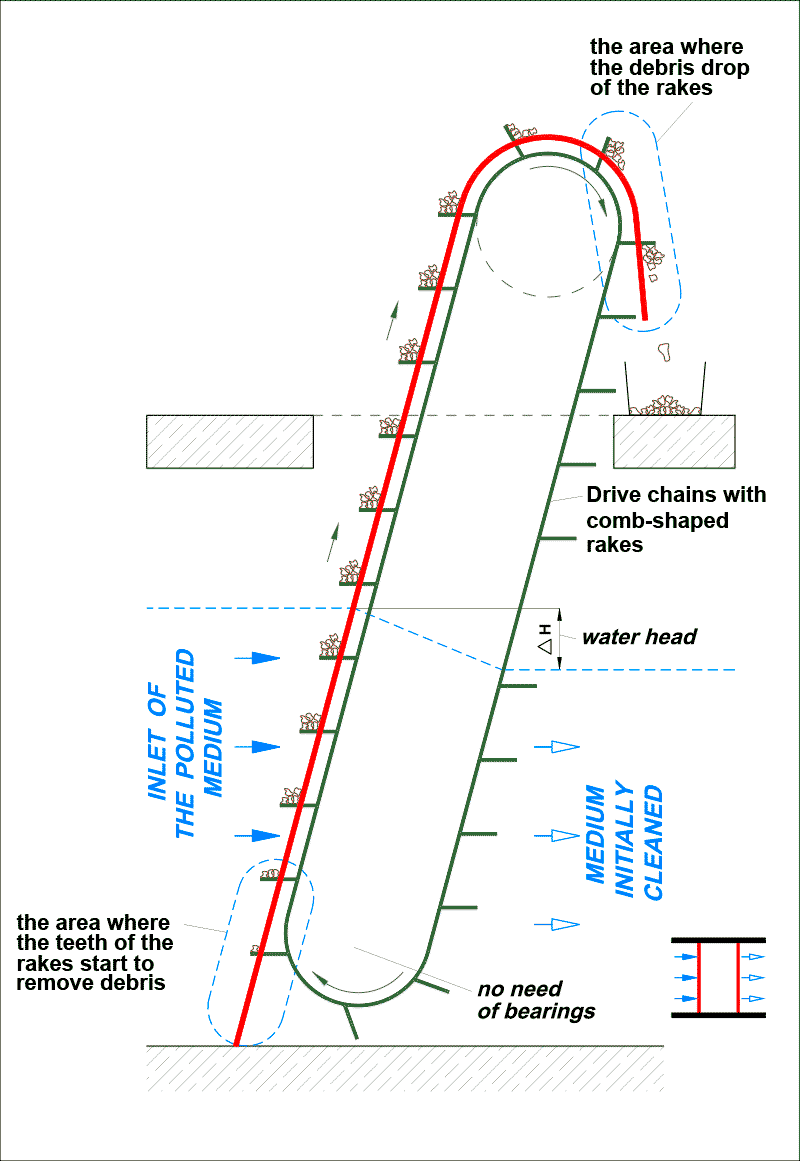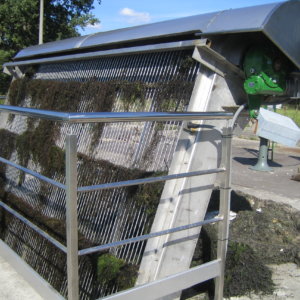PROFILTER mechanical bar screens
Design description
PROFILTER mechanical bar screens are innovative, original solutions for rough screening of water or wastewater. The innovation of our proven solution lies simply in the fact that the bar grate cleaning mechanism is arranged on the clean-water side of the grate, and it is therefore not exposed to the destructive influence of wastewater or sewage prior to cleaning. Depending on the type of the bar grate and the installation conditions, the separated trash can be collected in front of or behind the grate. The technical solutions used in PROFILTER self-cleaning bar screens reduce to a minimum the required staff assistance in their operation and considerably reduce the costs of their maintenance and overhaul.
Mechanical bar screen structure
The PROFILTER mechanical bar screen consists of the following main components:
- bar grate,
- bar grate cleaning mechanism,
- drive system,
- fixing guide system.
Installation process
Mechanical bar screens of large dimensions are delivered in parts and assembled on the site, and smaller units are delivered fully assembled, ready for installation in the channel.
Operation control
Mechanical bar screen operation can be controlled either manually, by switching the grate-cleaning mechanism on/off according to the need as assessed by the operator, or automatically. With automatic control, bar screen operation follows a pre-programmed algorithm that takes into account the water levels in the channel prior to and behind the screen. In addition, in the periods of low intensity of inflowing debris, bar screen operation will be switched on/off cyclically according to a pre-programmed time schedule irrespective of the height of the water head across the screen.
Maintenance and reliability
The PROFILTER mechanical self-cleaning bar screen is basically maintenance-free. In its technical solution we have eliminated the causes of the most common failures that require costly servicing in devices offered by other suppliers. We have eliminated all rolling elements that work in wastewater or sewage, which for this very reason are the first candidates for destruction in adverse environments. Their damage would result in an increased frictional drag, the unwanted extension and loosening of the drive chains and further serious failures.
With no rolling elements used, the driving chains in our devices are not prone to unwanted extension, so there is no need for an additional tension adjustment system, another cause of failures in bar screens of the traditional design.
Materials used
In our mechanical bar screens we use materials that ensure their reliability and long life:
- steel elements in contact with water: acid resistant steel or duplex stainless steel selected specifically for the expected chemical aggressiveness of the environment,
- drive chains: acid resistant steel, calibrated links,
- fasteners: acid resistant or duplex stainless steel,
- slide elements: polyethylene (PE) and other plastics.
Basic types of mechanical bar screens offered
- fine bar screens – with a clearance between the bars of 1 to 6 mm,
- course bar screens – with a clearance of more than 6 mm.

General schematic diagram
Design and operation principle
An array of vertical bars with some spacing between them, or the grate, is the main part of the screen, which is installed in the wastewater or sewage channel. A cleaning mechanism is required to remove debris from the grate. The grate cleaning mechanism of the PROFILTER bar screen consists of drive chains and a number of comb-shaped rakes attached between them, with the rake teeth engaged between the grate bars. The chains with the rakes are moved by the sprockets of an electrically operated drive shaft arranged at the top of the device. The slide guides secured to the side walls of the channel provide guidance for the drive chains and take over the thrust of the water on the grate. Moving upward between grate bars, the rakes sweep the debris off the grate and make it drop into a debris container or conveyor arranged behind the screen. The teeth of the rakes fully protrude between the grate bars into the front side of the grate as the rakes travel upward from the bottom of the channel to the top of the grate where the bars bend backward. When descending along the back of the top section of the grate, the rake teeth gradually retract from between the bars, allowing the debris to drop into the container behind the screen.
The comb-shaped rakes support the bar grate from the back side, and their teeth establish the clearances between the bars. With the grate cleaning mechanism arranged at the back – the clean-water side – its mechanisms are well protected from being blocked by the inflowing debris. The large number of cleaning combs aid in the efficient removal of debris, and thus provide good clearance between the bars on the whole working surface of the grate in the water.
The cross section of the bars can be specially shaped for optimum performance in terms of smooth water flow through the grate. An important feature of this design is that the grate bars are fixed only at the bottom of the channel and run separately in the whole working area up to their top ends, with the clearance between them sustained by the teeth of the cleaning rakes.
Mechanical bar screens are usually delivered as a whole and inserted into the channel provided with slide guides fastened to its walls by means of chemical anchors. In the case of very large sizes, the devices are supplied in parts and assembled on the site.
Important advantages of PROFILTER mechanical bar screens:
- high efficiency – effective removal of debris from the grate surface and from between the bars,
- very effective removal of fibrous trash, as the separate bars are effectively “combed” by the rakes, which prevents the build-up of trash in the clearance between them,
- very smooth flow, with the effective total clearance much larger than that which is available in other types of mechanical bar screens,
- simple design:
- no additional cleaning equipment, such as brushes and scrapers commonly required in other types of screens
- no chain tension adjustment,
- no rolling elements (rollers, bearings etc.) in the raw water zone,
- separated bars preventing trash jamming between them,
- easy servicing – replacement of worn out parts on the operation floor,
- easy replacement of individual grate bars,
- easy removal of the whole screen from the channel,
- drive motor placed at a height preventing it from flooding with sewage,
- high reliability, long inter-overhaul periods,
- very low noise level,
- low consumption of energy and overall operating costs.
Superior performance in hard operating conditions
Based on the experience gained from working with many sewage treatment plants, three main problems have been identified in the operation of mechanical bar screens.
Problem No. 1 – sand
Sand poses a serious challenge to the equipment for mechanical water cleaning. Flowing through bar screens or band screens, sand penetrates all possible slots and, acting like an abrasive, causes excessive wear of moving elements.
PROFILTER solution:
To minimize the losses caused by the destructive impact of sand, the construction of the mechanical bar screen has been significantly simplified. In particular, in our devices sand will not destroy any rolling element beneath the sewage surface because there are no rolling components at all in the PROFILTER solution; PROFILTER drive chains with comb-shaped rakes attached to them move along slide guides all the way round, including the bends at the bottom of the channel. The replacement of the drive chains is simple and easy as it is made from the operation floor level and can be carried out by the operating personnel alone. The automatic control algorithm, optimized for the specific conditions of the site, is a very important factor in extending the reliable operation of the device.
Problem No. 2 – fibrous sewage
This kind of sewage, either in the form of “braids” composed of smaller parts or in the form of scraps of rags or seaweed, tend to wrap themselves around any encountered obstacle. The bars of the grate are naturally such obstacles, and difficulties in the removal of fibrous sewage from between the bars must be taken into consideration. In extreme cases, which still cannot be avoided, troublesome manual removal of such trash can be necessary.
PROFILTER solution:
The bar grate of the PROFILTER mechanical bar screen is made of individual bars that are fully separated along their whole length. As a result, the teeth of the rakes can freely comb the clearances between the bars up to their bended top ends, where the trash drops to the trash container/conveyor behind the screen (see the scheme of the bar screen operation).
Problem No. 3 – pins, sticks, rubble, pieces of furniture and the like
Any such elements that, according to legal regulations in force, should not be present in sewage, still occasionally appear and clutter the grate surface or stick between its bars. In such cases, any automated cleaning mechanism may be ineffective and manual removal is necessary.
PROFILTER solution:
The bar grate as described above has the additional advantage that the clearances between the individual bars can vary slightly as permitted by the shape of the rake teeth. When a piece close to the bar clearance is trapped between two bars, the bars, which run independently of one another from bottom to top, are to a great extent flexible, so they will have a chance to slightly give way and the trapped piece will be released when the next rake comes. Fundamental to the resistance to such kinds of waste present in the sewage is the fact that the cleaning rakes move on the back side of the grate, so they will not collide with the debris on the front side.
Problem No. 4 – a sudden inflow of leaves, seaweed or frazil ice
A sudden inflow of leaves, seaweed or frazil ice may clog the screen.
PROFILTER solution:
The large number of cleaning combs moving at the same time aid in the efficient removal of debris, and thus provide good clearance between the bars on the whole working surface of the grate in the water.
It is thanks to the above described features and performance of PROFILTER mechanical bar screens that they have been recognized among users, and many such devices have already been installed in Poland and abroad (see our realizations). Among others, six mechanical bar screens have been successfully operating since 2012 at the inlet of the enormous sewage collector running under the bed of the Vistula River, passing sewage from the left bank Warsaw to the Czajka Sewage Treatment Plant on the Vistula’s right bank.
























